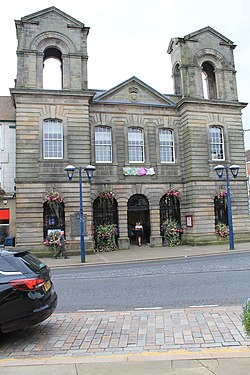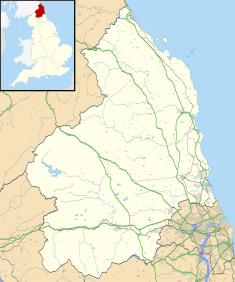Morpeth Town Hall is a municipal building in the Market Place, Morpeth, Northumberland, England. The structure, which was the meeting place of Morpeth Borough Council, is a Grade II listed building.[1]
| Morpeth Town Hall | |
|---|---|
 Morpeth Town Hall | |
| Location | Market Place, Morpeth |
| Coordinates | 55°10′02″N 1°41′26″W / 55.1673°N 1.6905°W |
| Built | 1714 |
| Architect | John Vanbrugh |
| Architectural style(s) | Baroque style |
Listed Building – Grade II | |
| Official name | The Town Hall |
| Designated | 22 August 1986 |
| Reference no. | 1042730 |
History
editThe building was commissioned in the early 18th century by the lord of the manor, the 3rd Earl of Carlisle.[2] It was designed by John Vanbrugh in the Baroque style, built in rusticated ashlar stone and was completed in 1714.[1][3] The design involved a symmetrical main frontage with five bays facing onto the Market Place with the end bays projected forward as towers with voussoirs and open pediments in the top stage.[1] The central section of three bays featured three arched openings containing wrought iron grills on the ground floor; there were segmental headed sash windows on the first floor and an entablature, a cornice and a pediment above with a coat of arms in the tympanum.[1] Internally, the principal rooms were the butter market and, behind it, the corn exchange on the ground floor,[4] and the assembly hall on the first floor.[1]
In September 1758, an army sergeant was killed and two other soldiers badly injured when 3,000 ammunition cartridges exploded in an accident in the town hall.[5] In the early 19th century theatrical events took place in the town hall with Macbeth being performed there.[6] After significant population growth, largely associated with Morpeth's status as a market town, the area became a municipal borough, with the town hall as its headquarters, in 1835.[7] The town hall was badly damaged in a fire in 1869 and the façade was subsequently restored, so as to create an exact reproduction of the original, and the structure behind it completely rebuilt; this was all at the expense of the 8th Earl of Carlisle, under the supervision of the local architect, Robert James Johnson.[8]
In February 1909, the suffragette and British Liberal Party politician, Alison Garland addressed a meeting in the town hall during which she spoke about votes for women as well as broader political issues.[9] In 1917, the industrialist Lord Joicey bought the town hall from the 11th Earl of Carlisle and presented it to the town, refusing to accept re-imbursement despite a fund raising campaign organised by civic officials.[10] The building then remained the headquarters of the borough council until it moved to new offices at No. 36 Bridge Street which were opened by the mayor, Richard Elliott, on 5 May 1939.[11][12]
The town hall remained the main venue for civic events in the town and later accommodated the offices of Morpeth Town Council as well as the local registrar's office: it also became an approved venue for weddings and civil partnership ceremonies.[13] An extensive programme of restoration works costing £1.1 million was commissioned by the Greater Morpeth Development Trust, carried out to a design by Napper Architects and was completed in 2009.[14] The works involved improved access to the butter market and the restoration of the grand staircase.[15] A bust, designed by Helen Ridehalgh, depicting the former Commander-in-Chief of the Mediterranean Fleet, Vice-Admiral Lord Collingwood, was installed in the butter market in March 2013.[16]
Works of art in the town hall include a portrait by Thomas Lawrence of the former Lord Privy Seal, the 6th Earl of Carlisle,[17] as well as portraits by Thomas Bowman Garvie of Alderman George Barron Grey[18] and of Alderman George Young.[19] Other items of interest displayed in the mayor's parlour include a strong box known as the "town hutch" commissioned by Lord Dacre and containing documents dating back to 1513, a ceremonial mace made in 1604 and several cannonballs used in the siege of Morpeth in January 1644 during the English Civil War.[20][21]
References
edit- ^ a b c d e Historic England. "The Town Hall (1042730)". National Heritage List for England. Retrieved 17 August 2021.
- ^ Lewis, Samuel (1848). "'Morley - Morton-upon-Lug', in A Topographical Dictionary of England". London: British History Online. pp. 345–350. Retrieved 17 August 2021.
- ^ Pevsner, Nikolaus; Grundy, John; Mccombie, Grace; Ryder, Peter; Welfare, Humphrey (1992). Northumberland (Buildings of England Series). Yale University Press. p. 73. ISBN 978-0300096385.
- ^ "Big turnout for public meeting on major plans". Morpeth Herald. 11 November 2016. Retrieved 17 August 2021.
- ^ Richardson, Moses Aaron (1843). The Local Historian's Table Book, of Remarkable Occurrences. Vol. 2. J. R. Smith. p. 77.
- ^ Blakey, Robert (1879). Memoirs. Trübner & Co. p. 13.
- ^ "Morpeth MB". Vision of Britain. Retrieved 17 August 2021.
- ^ The Post Office Directory of Durham and Northumberland. 1879. p. 648.
- ^ Armstrong, Craig (2020). Struggle and Suffrage in Morpeth and Northumberland: Women's Lives and the Fight for Equality. Pen and Sword. p. 32. ISBN 978-1526719652.
- ^ Hardy, Stewart (2014). "Tunes Composed for Morpeth Town Hall's 300th Anniversary" (PDF). Retrieved 17 August 2021.
- ^ Plaque on the front of the Bridge Street building
- ^ "No. 41035". The London Gazette. 29 March 1957. p. 1978.
- ^ "Morpeth Town Hall". Morpeth Town Council. Retrieved 17 August 2021.
- ^ "Annual Report 2019" (PDF). Greater Morpeth Development Trust. Retrieved 17 August 2021.
- ^ "Morpeth Town Hall". Napper Architects. Retrieved 17 August 2021.
- ^ "Tribute to naval hero Lord Collingwood is unveiled in Morpeth". Morpeth Herald. 8 March 2013. Retrieved 17 August 2021.
- ^ Lawrence, Thomas. "George Howard (1773–1848), 6th Earl of Carlisle". Art UK. Retrieved 17 August 2021.
- ^ Garvie, Thomas Bowman. "George Barron Grey, Member of Morpeth Borough Council (1868–1913), Elected Alderman (1882), Mayor (1876 & 1906)". Art UK. Retrieved 17 August 2021.
- ^ "George Young, Member of Morpeth Borough Council (1884–1915), Elected Alderman (1899), Mayor (1887 & 1901)". Art UK. Retrieved 17 August 2021.
- ^ "Morpeth Town Treasures". Greater Morpeth Development Trust. 19 September 2019. Retrieved 17 August 2021.
- ^ "Delving into the history of the Town Treasures". Morpeth Herald. 27 November 2016. Retrieved 17 August 2021.
Further reading
edit- Bibby-Wilson, Kim (2014). Morpeth Town Hall and its Treasures. Morpeth Antiquarian Society. ISBN 978-0953381852.
